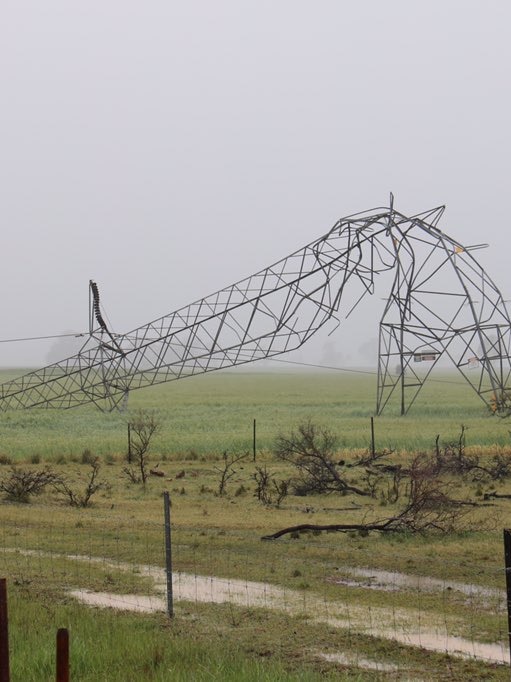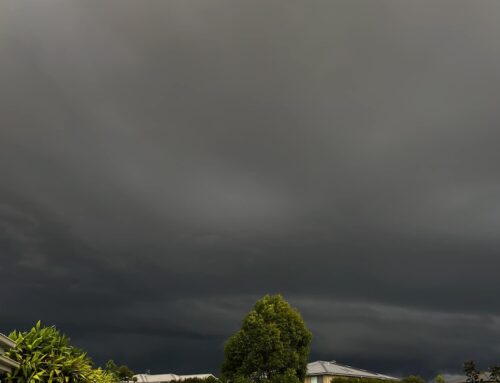Among the more surreal and enduring images from South Australia’s infamous statewide blackout are the photos of electricity transmission towers collapsed and contorted in foggy fields.
On the afternoon of September 28, 2016, twin tornados ripped through SA’s mid north, damaging critical infrastructure and shutting off power to the entire state.
More than 20 of the giant pylons were knocked out, folding in on themselves as if Uri Geller had somehow magicked them into submission.
Around 4:00pm, more than 850,000 homes and businesses were plunged into a darkness that lasted for hours, with some properties going without power for days.
AAP: David Mariuz
)An early estimate of the economic impact concluded that the blackout cost businesses more than $360 million.
But in the cold, hard light of day, it did not take long for the fallout to begin.
The blackout triggered recriminations, as well as ongoing reforms to the state’s — and the nation’s — approach to energy security.
Here’s a look at what has happened as a result of the events of half a decade ago.
Elon and Tesla build a giant battery
Within six months of the blackout, Tesla boss Elon Musk famously declared his company could install a battery farm capable of “fixing” SA’s power system within 100 days, or else do it for free.
Four months later, the SA government and then-premier Jay Weatherill announced a deal with Tesla to build a 100-megawatt battery near Jamestown.
The battery was launched on deadline in November 2017, and last year had its capacity expanded by 50 per cent.
But while the blackout produced a burgeoning “bromance” between Mr Musk and Weatherill, it also produced another memorable moment.
Days after the Tesla boss threw down his initial challenge, then federal energy minister Josh Frydenberg held a press conference, which was subsequently gatecrashed by Mr Weatherill.
Mr Frydenberg was asked whether it was “a bit awkward” to be sharing a platform with a political opponent, when Mr Weatherill interjected “it’s about to be” before laying into the federal government.
Loading
The Premier said it was “galling” to be standing beside Mr Frydenberg after he and Prime Minister Malcolm Turnbull had spent the past six months “bagging South Australia at every step of the way”.
“It’s a disgrace the way in which your government has treated our state,” he said.
“It is the most anti-South Australian Commonwealth government in living history.”
Mr Frydenberg then accused a “desperate” Mr Weatherill of “crash tackling” his announcement.
Renewables: Reckoning or revolution?
A more immediate impact of the blackout was an intensification of the nation’s energy wars, with opinion divided on whether renewables were the problem or the solution, a debate which still continues to this day.
Less than three months ago, the owners of two SA wind farms were ordered to pay more than $1.6 million in penalties for breaching National Energy Rules in the lead-up to the 2016 blackout.
ABC News: Lincoln Rothall
)A formal review of the blackout found overly sensitive protection mechanisms in some South Australian wind farms were to blame.
The Australian Energy Market Operator (AEMO) found the unexpected operation of the control settings resulted in the sudden loss of generation from the wind farms.
But the nation’s energy regime has evolved since the blackout and new maximum penalties for breaches of some parts of the National Energy Laws can see businesses fined more than $10 million.
From batteries to VPPs
There are several virtual power plant (VPP) schemes running in SA.
The general idea is that by sharing surplus energy produced by rooftop solar panels when not being used, all consumers can benefit.
Key to these systems are smart meters and other technology which can figure out automatically which system is producing surplus power and whether that can be stored or moved to another customer.
In early 2018, just over a year after the blackout, Tesla and the former SA government cut another deal involving energy storage.
But this time, instead of one giant battery, it involved thousands of smaller ones.
The plan was to deliver solar panels and batteries to 50,000 homes to slash household power bills and create the world’s largest (VPP).
In June this year, the current government announced the scheme would be expanded to allow low-income South Australian residents without solar panels to participate.
Flattening the ‘duck curve’
South Australia’s reliance on renewables has only grown since 2016.
For just over an hour on October 11, 100 per cent of energy demand was met by solar panels alone — making the state the first major jurisdiction in the world to be powered entirely by solar energy.
One in four Australian homes has solar capability — which is among the highest rates anywhere in the world — while the uptake is even higher in SA, with about one in three homes estimated to have rooftop solar.
The result has been what is known as the “duck curve” — a term that refers to changes in the graph of energy demand.
“Due to the large penetration of solar in our network, a new ‘off-peak’ time has been created in the middle of the day with distribution feeders sometimes acting as generators over this period,” the Australian Energy Regulator (AER) said, in a 2014 report.
The challenge for energy policy makers has been how to flatten that curve.
In June this year, the SA Government warned of the “risk of another statewide blackout” due to system overload, if supply were ever to outstrip demand.
While giant batteries, which help to capture excess generation by storing it for the proverbial rainy day, are one way to manage the problem, there are currently a range of other strategies in place.
Last month, power companies were granted the power to charge Australians with rooftop solar panels for exporting electricity to the grid, under new rules introduced by the Australian Energy Market Commission (AEMC).
About 20 per cent of all customers now partly meet their electricity needs through rooftop solar power generation, up from just 0.2 per cent in 2007, and that is predicted to more than double over the next two decades.
“As we go from 20 per cent to 50 per cent and beyond, the grid needs to change,” AEMC chief executive Benn Barr said.
New infrastructure
Critical infrastructure has been boosted in the five years since the September blackout, including power station upgrades and investment in diesel turbines units to provide back-up power.
Earlier this year, the Australian Energy Regulator (AER) granted final regulatory approval for an interconnector between South Australia and New South Wales.
Supplied: ElectraNet
)Five years on from the 2016 catastrophe, energy is already looming as a key electoral battleground.
But while the Liberals and Labor have both committed to bolstering energy security, they are at odds over how to best to do that.
In its first major policy announcement ahead of the March 2022 state poll, Labor committed to building a 200 megawatt (MW) hydrogen power plant and storage facility.
But Energy Minister Dan van Holst Pellekaan expressed reservations, saying locally-produced hydrogen gas was already being exported.
Posted , updated




